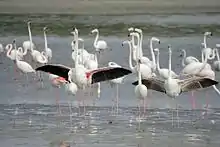Ras Al Khor
Ras Al Khor Wildlife Sanctuary (Arabic: رَأْس ٱلْخَوْر, romanized: Raʾs Al-Khawr) is a wetland reserve in Dubai, renowned for attracting large numbers of migratory birds.[2] It is also home to a large population of crustaceans, small mammals, and fish.[3]
| Ras Al Khor | |
|---|---|
| رَأْس ٱلْخَوْر | |
 One of the three hides at the Ras Al Khor Bird Sanctuary | |
 | |
| Location | Dubai Creek, Dubai |
| Nearest city | Ras Al Khor Industrial Area, Nad Al Hammar, Umm Ramool, Al Garhoud |
| Coordinates | 25.193°N 55.323°E |
| Area | 1,300 ha (5.0 sq mi) |
| Website | dm |
| Official name | Ras Al Khor Wildlife Sanctuary |
| Designated | 29 August 2007 |
| Reference no. | 1715[1] |
Overview
Ras Al Khor Wildlife Sanctuary represents an enclave of relative wilderness amidst traffic and sprawling urban infrastructure. Located just as the name in Arabic suggests, at the Cape of the Creek, it is among the few urban protected areas of the world.
The Dubai Municipality has taken great efforts to protect and preserve the biodiversity of this delicate ecosystem. The wetland has been fenced off from the public and three birding hides have been built. The bird hides are a first step towards the development of more elaborate visitor education facilities in the protected area. The WWF UAE Project Office collaborated with Dubai Municipality's Environment Department, in setting up the facilities that were sponsored by the National Bank of Dubai.
Opportunities for experiencing a natural environment in this rapidly expanding emirate are so limited that the opening of Ras Al Khor to visitors is a boon to present and potential nature lovers.
There are three birding hides located on the perimeter of the sanctuary open to the public.[4] Entrance is free and the sanctuary operates from 7:30am-5:30pm in the Winter and 6:00 am to 6:00 pm in the Summer.[5]
Ras Al Khor is also home to about 470 species of fauna and 47 kinds of flora.[6] Greater flamingoes (Phoenicopterus roseus), are one of the main attractions in the preserve.[7]
Species

Some of the regular visitors to the sanctuary are:
- Asian pied myna
- Black-winged stilt[3]
- Blue-cheeked bee-eater
- Caspian tern
- Citrine wagtail
- Common greenshank
- Common hoopoe
- Common kingfisher
- Common sandpiper[3]
- Common snipe
- Cormorant[3]
- Curlew
- Dunlin
- Eurasian marsh harrier
- Great black backed gull
- Great egret[3]
- Greater flamingo[3]
- Grey francolin
- Grey heron[3]
- Grey plover
- Indian peafowl
- Indian roller
- Indian silverbill
- Isabelline shrike
- Little bittern
- Little green bee-eater
- Malabar lark
- Mallard
- Osprey[3]
- Pied avocet
- Purple sunbird
- Red-vented bulbul
- Red-wattled lapwing
- Ringed plover
- Ruddy turnstone
- Sanderling
- Snowy plover
- Spotted eagle
- Terek sandpiper
- Western heron[3]
- White wagtail
- White-eared bulbul
- Yellow billed stork
Gallery
See also
References
- "Ras Al Khor Wildlife Sanctuary". Ramsar Sites Information Service. Retrieved 25 April 2018.
- "Ras Al Khor Wildlife Sanctuary | Visit Dubai". www.visitdubai.com. Retrieved 2022-11-09.
- "View thousands of birds at Ras Al Khor". Visit Dubai. Retrieved 2018-04-02.
- "Ras Al Khor Wildlife Sanctuary | Visit Dubai". www.visitdubai.com. Retrieved 2022-12-13.
- "Plan Your Visit". www.dm.gov.ae. Retrieved 2022-12-13.
- "Ras Al Khor Wildlife Sanctuary | Visit Dubai". www.visitdubai.com. Retrieved 2022-12-13.
- "Wildlife". www.dm.gov.ae. Retrieved 2022-12-13.


